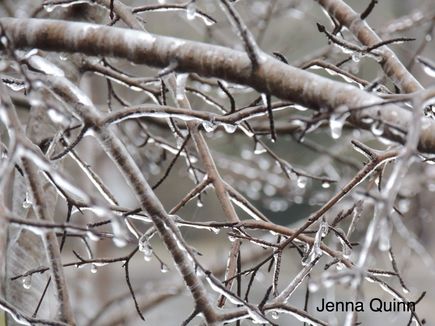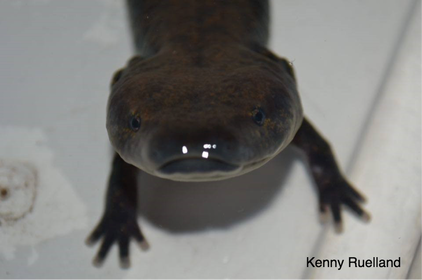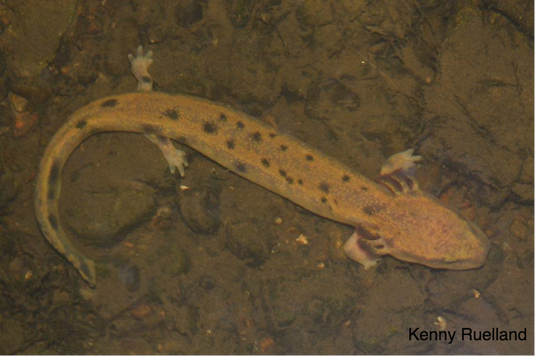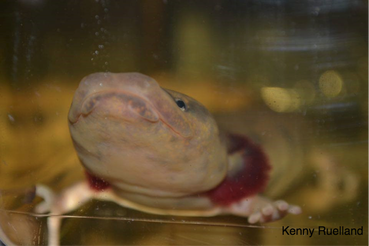|
By Jenna Quinn Scarves, mittens, toques, snow pants, and boots; In Canada, we know how to bundle up to beat the cold. Even our wildlife has to adapt to winter weather and different species use a variety of interesting and sometimes unique ways to keep warm each winter. Perhaps most noticeable are the species that simply flee the cold for a southern vacation. Many birds and large mammals avoid the blustery winter weather by travelling to a warmer spot, where there is more food to be found. The Arctic Tern makes the longest annual migration of any bird. According to the Greenland Institute of Natural Resources, it travels an incredible 71,000km each year! Conversely, some herds of Woodland Caribou migrate only short distances to the closest location where they can still find food. Another strategy is to sleep through the snow. This can be tempting to even the toughest Canadian when the temperature drops below -30°C, and a warm bed is waiting. Some bears, bats, chipmunks, salamanders, and bees all hide away in caves, underground, or in tree or rock crevices and sleep until spring. Garter Snakes hide out in large groups over winter and are quite the spectacle to see when they emerge the following spring. Some species make seemingly small, but important changes, thickening up their fur coats for the winter and wearing white to camouflage against the snow. For example, the Arctic Fox uses a warm white winter coat to survive the cold. Rabbits, among others, switch their diets from grasses and herbs to bark, twigs, and buds which are much easier to find in winter. Most butterflies endure the winter in a different lifecycle stage, as an egg or chrysalis that has a tough outer shell able to tolerate the cold weather. Interestingly, the Mourning Cloak butterfly, common in southern Ontario, remains in its delicate butterfly state all winter. It finds a crack in a tree or rock and snuggles in for a long rest. This allows it to be the first butterfly out in the spring, getting first dibs on the food before more competition arrives. One of the most fascinating winter survival strategies is that of the Wood Frog, an amphibian found across Canada including the tundra. To survive these chilly conditions, the Wood Frog stays near the surface of the ground, just below the leaf litter, and actually freezes and thaws with the surrounding environment. There are special proteins in the frog’s blood that allows it to freeze, which keeps ice from forming in the cells by dehydrating them. This prevents the frostbite we get if our skin is exposed to freezing temperatures. Don’t let the cold keep you indoors this winter! Get outside and see what evidence you can find of Canada’s winter wildlife. This blog is also posted on the rare Charitable Reserve's blog.
1 Comment
By Jessica Ferguson Amphibians are cool. They were the first vertebrate to step out of the water, become terrestrial, and sprout some limbs and lungs (thanks, amphibians!). They are widely distributed, and can be found on every continent except Antarctica. They are indicator species, as they are sensitive to pollutants present in the water. Their early life-stage development is a throwback, indicating that they were once fully aquatic. There is incredible diversity in amphibians and their reproductive processes, but to summarize greatly, they lay eggs in the water, which hatch into aquatic larva equipped with gills, and later transform into their mostly-terrestrial adult stage complete with lungs. That is true for many Ontario amphibians, but not for the Mudpuppy (Necturus macolosus). This unique, fully aquatic salamander lays eggs in late spring, which are then possibly guarded by the females… who possibly stay with the young for a while after they hatch… We’re not completely sure, but more on that later. They take two to six years to fully transform into adults, and live for about 30 years. Although Mudpuppies can breathe oxygen through their skin like other amphibians, they retain their external, feathery, red gills into adulthood. This is the key identification feature for the species. Additionally, they are much larger than our other Ontario salamanders, reaching almost 50 cm in length. Even as juveniles they are about twice the size of the larva of other species. They have thick bodies and stubby legs, adorable beady little eyes, and are grey to rusty brown in colour with dark spots on their dorsal and lateral surfaces. Mudpuppies enjoy long walks along muddy river bottoms, and hiding under submerged rocks and logs. They are found in aquatic environments that don’t fully freeze in the winter. In fact, contrary to the behaviour of their hibernating cousins, they are actually active during the cold winter months. They are also carnivores and like to snack on aquatic insects, fish, fish eggs, worms, and crayfish. But here’s the thing: other than that, we actually don’t know very much about Mudpuppies. Because they are nocturnal and lay low at the bottom of waterbodies, they are seldom seen. Despite their elusive nature, we can still determine, through surveying efforts, that they are not a species at risk. They are not immune to the pressures that face their semi-terrestrial cousins, though. Pollution is a major issue, as is the case for all amphibians due to their incredibly porous skin. In the St. Lawrence River, over 60% of Mudpuppies examined had evidence of deformities due to high PCB levels (Fisher et al, 2007). Habitat loss and shoreline development are also problematic. However, an extra pressure Mudpuppies face is that they are often killed when caught by anglers who mistakenly believe them to be venomous. Mudpuppies are completely harmless. If you ever catch a Mudpuppy while fishing, gently take it off the hook, and release it back into the watery depths from whence it came. If you are unsure if it is a Mudpuppy or a fish…well, Mudpuppies have legs! There are very few reasons I would plunge my hands into icy water, but I have for a Mudpuppy. Despite scouring river bottoms, I have not yet had the chance to see one in the wild so I went to my friend, Kenny Ruelland, for his first experience with these cryptic creatures. Kenny said, "I will never forget my first time seeing one of these giant, neotenic (aquatic) salamanders. It was early March, the temperatures were around -25C. After about 40 minutes of wading through the icy water - there it was! My first ever Mudpuppy came emerging from under a sheet of ice." Finding excitement in such a strange creature may seem odd to some, but I’m sure that many have felt the same surge when they spot an owl hiding in the treetops, or watch a moose raise its head to solemnly watch you paddle by. Amphibians play an important role in our ecosystems, and we need to encourage people to be passionate about them to conserve the species and their habitats. Because there is so little known about Mudpuppies, every little bit helps. If you see one (or any reptile or amphibian in Ontario), report your sighting to the Ontario Reptile and Amphibian Atlas. Even incidental sightings can really help shed some light on this unique and under-surveyed species! This blog is also posted on Earth Unfiltered.
|
ELB MembersBlogs are written by ELB members who want to share their stories about Ontario's biodiversity. Archives
January 2023
Categories
All
|







 RSS Feed
RSS Feed